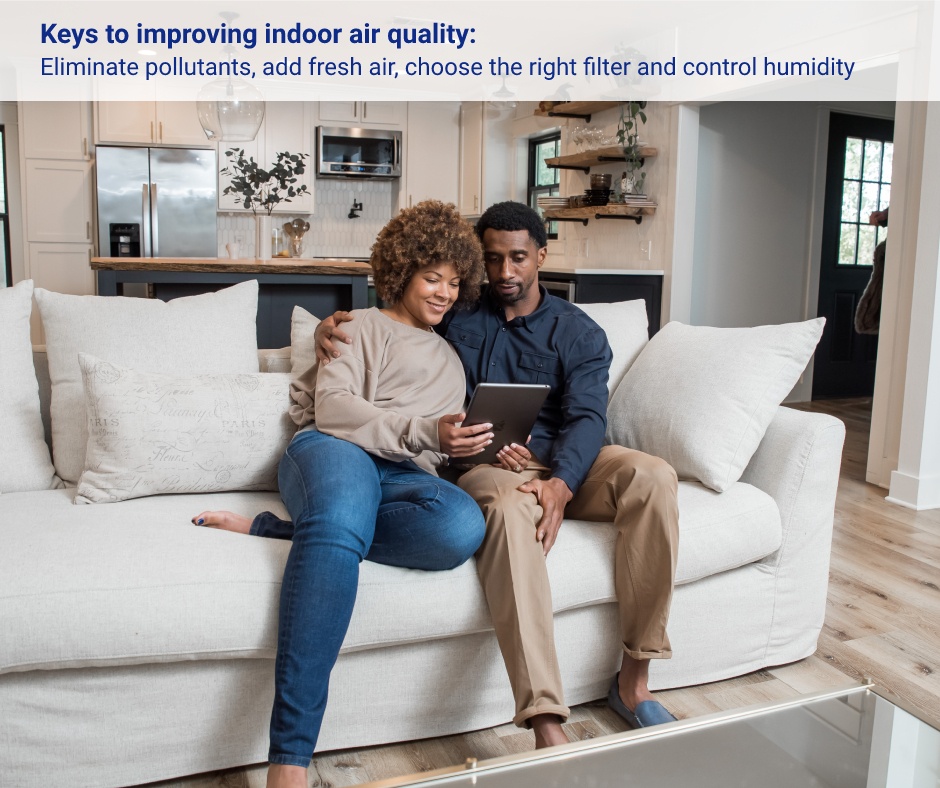Eliminate pollutants, add fresh air, choose the right filter and control humidity.
Home serves as our safe haven and refuge away from the world, but how often do we think about the quality of the air inside it? Most likely, not often enough. Yet we should considering the EPA findings that indoor air pollutant levels are two to five times higher than outdoor levels, and we spend 90 percent of our time indoors.
Take a moment to sit in your favorite spot in your home and consider how comfortable you are and the environment around you. Ask yourself these questions:
- Do you struggle with dust, pet dander and other airborne pollutants?
- Does the air feel too dry or too damp?
- Is the temperature comfortable and does it stay comfortable with little effort?
These factors all play roles in the quality of air you breathe and the overall feeling inside your home.
Let’s walk through a few actions you can take to improve the air within your home by removing air pollutants, adding fresh air, increasing filtration and managing humidity.
Take control of air pollutants
Some sources of air pollution come from within our own homes – like pet dander, dust mites and household chemicals. It’s possible to lessen the impact of these at air pollutants with regular cleaning and reducing the amount of clutter in a home.
Use a HEPA-quality vacuum cleaner frequently on rugs, carpets, furniture and pet bedding frequently.
Place covers on your mattresses, pillows and box springs, and washing your bedding in hot water at least once a week to combat dust mites. The Asthma and Allergy Foundation of America recommends a washing machine water temperature of 130 degrees Fahrenheit or hotter, as well as drying the bedding on a hot cycle to kill dust mites.
Bring in fresh air
When the sources of indoor air pollutants can’t be fully eliminated, consider supplying clean, fresh air to the indoor environment while exhausting stale and polluted air back outside.
Here are some dos and don’ts for freshening the indoor air:
Do
- Filter kitchen air by running the kitchen vent fan while cooking
- Continuously filter the air in your home by running your HVAC fan
- Consider adding a ventilator to your HVAC system like the Envirowise ERV that brings in fresh air and puts it through your home’s filter while pushing out the stale air.
Don’t
- Open a window, especially if you suffer from asthma or allergies. While it may allow for air exchange, it doesn’t filter the air or block the allergens or asthma triggers that could intrude your home.
Increase your HVAC’s filtering power
Adding a higher quality disposable filter or a whole-home air cleaning system to your HVAC also can help remove airborne particles and provide cleaner air to every room.
Disposable air filters – When selecting a disposable filter, look for the MERV rating. The higher the rating, the more it will filter out of your air. We suggest using MERV 11 filters that are changed every 30-90 days.
Whole home filtration – When you add a whole home air cleaner like Trane CleanEffects, which can remove up to 99.98% of all airborne particles and is up to 100 times more effective than a standard 1-inch filter. Trane CleanEffects is also certified as asthma and allergy friendly by the Asthma and Allergy Foundation of America, and best of all it does not require any costly replacement filters and can be cleaned at home as needed.
Balance the humidity in your home
Maintaining a humidity level of between 35 and 60 percent in the home keeps your home both more comfortable and avoid issues that arise when it the air is too damp or too dry.
Mold, dust mites, and other air pollutants tend to thrive outside of that range, and our bodies’ natural immune systems can be comprised when the air gets too dry. Air that is too wet can also cause issues for the home such as warping or cracking wood furnishing and floors.
It’s possible to monitor your humidity level by using a reliable HVAC thermostat.
Decrease humidity
- Remove some humidity when showering by turning on the bathroom fan before, after and during a shower
- Run your air conditioning unit. However when temperatures are mild the HVAC may not run enough to remove moisture from the air.
- Consider adding a dehumidifier to your HVAC system.
Increase humidity
- In drier climates or during dry seasons, add humidity through a whole-home evaporative or steam humidifier. It ties into the HVAC ductwork system and adds the appropriate amount of moisture to maintain ideal humidity levels throughout the entire home.
By actively addressing Indoor Air Quality though steps both big and small we can create a cleaner and healthier environment for our families.








